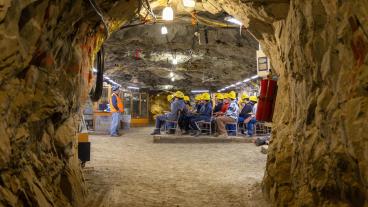Students in the College of Engineering and Computational Sciences Senior Design Program are building a lunar mining rover with technology that could support driverless vehicles.
Electrical engineering senior Megan Salinas is one of a 16-member multidisciplinary student team called Blasterbotica. She said their project “supports robotic mining technology in deep mines and Australian deserts, to self-driving cars in California.”
“The sensing and driving technology we are researching could develop into your personal driving chauffeur,” said Salinas.
Students have to apply to be a part of the team and are selected by administrators in the Senior Design Program. Two senior design teams working on locomotion and autonomy subsystems are reusing a rover built last year to make improvements for this year’s project.
“I was interested in the coding and autonomy aspects of this project,” mechanical engineering senior Ryan Stauffer said. “They wanted computer science students so it was a perfect fit for me.”
The class is designing and building a mining rover for NASA as part of a Regolith Mining Competition. In its fifth year in the competition, Mines must develop a winning robot that will excavate and deposit a lunar regolith simulant (rock powder), traverse an obstacle area and deliver the materials to a collection container. The winner of the competition will receive a $3,000 team scholarship and an invitation to watch a rocket launch at the Kennedy Space Center in Florida in the spring.
Chris Dreyer is the faculty advisor for the team and an assistant research professor in the mechanical engineering department.
“NASA created the competition to develop technologies for and promote the concept of space resource utilization—and STEM education,” Dreyer said.
The team often does testing on the Golden volleyball sand pits, as it is a convenient substitute until a regolith test bed is ready. Dreyer said that regolith is a difficult material to drive on and can confound sensors.
“It is an interesting robotics problem because the environment is difficult to predict,” Dreyer said. “No team has completed the competition with an autonomous rover.”
In addition to support from the program, the team raises funds through donations for most of their expenses. Angel Abbud-Madrid, director of the Center for Space Resources, also helps sponsor the team by providing funds and an assembly and testing workspace in the center’s lab on the Mines campus.
“This project directly relates to the research we are conducting at the center,” Abbud-Madrid said. “We are learning how to design autonomous systems for remote space applications. This particular project is beneficial because it brings all expertise of Mines together for this purpose.”
The Senior Design class has a website at inside.mines.edu/25763-php. The team has a website at blasterbotica.mines.edu.
Blasterbotica is looking to expand student participation beyond the senior design groups. Students interested in helping out can contact Dreyer at cdreyer@mines.edu.
Contact:
Kathleen Morton, Communications Coordinator / 303-273-3088 / KMorton@mines.edu
Karen Gilbert, Director of Public Relations / 303-273-3541 / KGilbert@mines.edu



